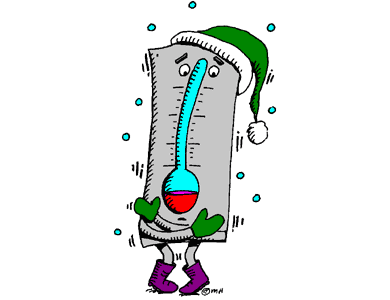How to Get out of a Cold Weather Slump

Winter Hibernation
Jen wants to know how to get out of a cold weather slump. She believes that colder temperatures put her in a slump where all she wants to do is curl up on the couch under a warm blanket. She wants to know ways to feel better.
Cara shares that she too experiences a winter slump and shares that she gets as much light as possible during the day, and plays sounds of birds chirping and other sounds of spring. This seems to help her out of her winter slump.
Jen associates the slump with cold temperatures and Cara associates the slump with light and springtime. Both are aware that they seem to hibernate in the winter. People do sleep and eat more in the winter, and are less interested in usual activities. They are not necessarily sad, but slowed and disinterested. Some people are more aware of and sensitive to these changes than others.
Winter Blues
The changes in appetite, energy, sleep and interest are not related to temperature changes in the winter, though. They are related to changes in light.
Cause: Decreased Light
The changes in appetite, energy, sleep and interest are not related to temperature changes in the winter, though. They are related to changes in light. There are fewer daylight hours in the winter. A person who is sensitive to changes in light can experience a winter slump even in southern areas where there is ample light. A person who is not so sensitive to light changes will not experience a winter slump even in northern areas where there is little sunlight in the winter.
People with depression and bipolar disorders are often very sensitive to changes in light. People who have depression and bipolar disorders may have a mood episode any time of year, but are more likely to have a depressive episode during the winter. A person with bipolar disorder is most likely to have a manic or mixed episode in the spring or summer – when we have more daylight hours. A person who only experiences depression and only in the winter might have Seasonal Affective Disorder or SAD. SAD is rare though, and affects only 1-2% of the population. The “winter blues” are much more common. These are depression like symptoms that are not full blown clinical depressions. They occur in 1% of the population in tropical climates and 10% of the population in northern climates.
Light is related to our circadian rhythm; our sleep-wake cycle. In the spring and summer, when light increases and sleep decreases, we experience an antidepressant effect. A person with bipolar disorder can experience mania. In the winter, when light decreases and sleep increases, we experience depression. Changes in light change our circadian rhythm. Most of us are not affected or aware of the affects. Others are very dramatically affected.
Remedy: Increase Light
Understanding what causes a winter slump or “winter blues” helps us understand what we can do to feel better when we notice the symptoms and behaviors. In the winter, increase exposure to light by going outside, without sunglasses, for an hour at noon and sleep with all the blinds up. In the summer, reduce exposure to sunlight, wear sunglasses and use dark window shades. Light box treatment is used to treat SAD and can also be use for “winter blues.”
A light box, used every morning for 30 minutes can produce an antidepressant effect within 1-2 weeks; faster than medication that can take 4-6 weeks. Adjustments can be made, as needed, in how often and how long the sessions last. Treatments can begin in October when natural daylight decreases and stop in March when daylight increases.
As mentioned, increased light has an antidepressant effect and can trigger a manic episode. A person with bipolar disorder is at increased risk of suicide during a mixed depressed and manic state, which is most likely to occur in April, when sunlight increases. Use of a light box would not be indicated for a person with bipolar disorder.
Light Therapy
A light box, used every morning for 30 minutes can produce an antidepressant effect within 1-2 weeks; faster than medication that can take 4-6 weeks.
Caution
Use of a light box would not be indicated for a person with bipolar disorder. A person with bipolar disorder can experience mania and increased risk of suicide.
Reference:
Medscape Psychiatry; "The Truth About Seasonal Affective Disorder"; Nassir Ghaemi, MD, MPH; Posted: 02/03/2011
This content is for informational purposes only and does not substitute for formal and individualized diagnosis, prognosis, treatment, prescription, and/or dietary advice from a licensed medical professional. Do not stop or alter your current course of treatment. If pregnant or nursing, consult with a qualified provider on an individual basis. Seek immediate help if you are experiencing a medical emergency.
© 2011 Kim Harris








